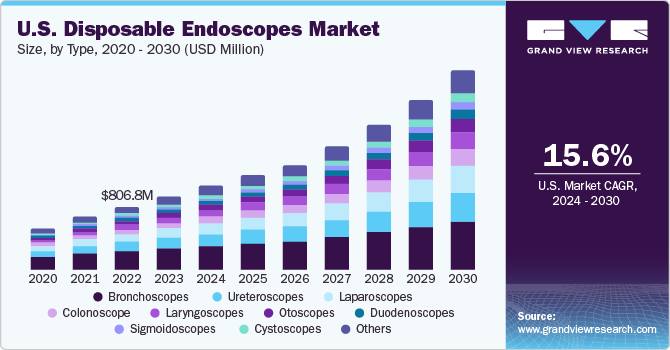Disposable Endoscopes Industry Overview
The global disposable endoscopes market size was valued at USD 1.7 billion in 2021 and is expected to expand at a compound annual growth rate (CAGR) of 17.0% from 2022 to 2030. The growing cross-contamination issue of reusable endoscopes is one of the major factors expected to drive market growth. In 2020, Mr. Brian Dunkin MD, CMO of Boston Scientific Endoscopy stated that one in 20 patients has a pathogen contamination concern. Moreover, several tedious sterilization steps to eliminate all kinds of microorganisms from the reusable endoscopes are also expected to increase the adoption of disposable endoscopes.

For instance, according to Boston Scientific, cleaning of endoscopes during ERCP procedures requires over 100 series of manual steps to reuse and it’s also vulnerable to error. Furthermore, the increasing preference of medical professionals to use single-use or disposable endoscopic devices is supporting the market growth. For instance, The Centers for Medicare & Medicaid Services (CMS) 2020 has released a new device passcode for single-use endoscopes. Hospitals and Ambulatory Surgical Centers (ASCs) use this code for treating Medicare patients in the U.S. using single-use duodenoscopes.
Gather more insights about the market drivers, restraints, and growth of the Global Disposable Endoscopes market
A moderate impact has been observed during the COVID-19 outbreak on the disposable endoscope market growth. The decrease in the number of surgical procedures due to the COVID-19 pandemic also hampered product adoption. In addition, the shortage of medical staff due to the increased infection risks associated with the cleaning of endoscopes also increase the adoption of single-use devices during the COVID-19 pandemic. For instance, according to a study reported in the Journal of Bronchology & Interventional Pulmonology in 2021, in the U.S., about 11% of health workers were infected with COVID-19 and in Italy, the percentage is approximately 20%.
However, the demand for single-use endoscopes is expected to increase with the gradual depart of COVID-19 due to its safety and elimination of the possibilities of infection. Furthermore, single-use devices are more cost-effective than reusable ones, which is expected to drive market growth. For instance, according to the data published by the Association of Anesthetics in November 2019, the mean cost per patient for reusable flexible bronchoscopes is £511.00 with an associated risk of infection of 2.8%. The estimated mean cost of single-use flexible bronchoscopes per patient is £220.00 and a 0% risk of infection.
Similarly, in 2019, a study published in Chest Journal reported that reusable bronchoscopes used by hospitals are paying about 21% to 155% more per instrument as compared to disposable endoscopes. Consequently, the cost-effectiveness, lower chances of cross-contamination, and minimum resource utilization are in turn expected to propel the market growth over the forecast years. Rapid technological advancements coupled with the growing investments by key manufacturers to develop new, innovative products are anticipated to drive the market further. For instance, in May 2020, Ambu A/S, a single-use endoscope manufacturer, launched Ambu aView 2 Advance, a display unit for single-use endoscopes.
This product is a mobile platform and can be used in different types of endoscopic devices including rhinolaryngoscope, bronchoscope, and cystoscopes among others. Omnivision, in November 2020, introduced imaging subsystems including image signal processor boards, camera modules, and cables for disposable endoscopic devices. Moreover, in November 2020, Olympus Corporation made partnerships with Ruhof Corporation and launched single-use procedure kits and hybrid tubing for endoscopes to reduce infection risks. Thus, the development of visualization systems and components for re-usable endoscopes is supporting the market growth.
Browse through Grand View Research's Medical Devices Industry Research Reports.
Rigid Endoscopes Market - The global rigid endoscopes market size was valued at USD 6.0 billion in 2022 and is projected to expand at a compound annual growth rate (CAGR) of 7.1% from 2023 to 2030.
Endoscopes Market - The global endoscopes market size was valued at USD 13.6 billion in 2022 and is expected to expand at a compound annual growth rate (CAGR) of 9.4% from 2023 to 2030.
Disposable Endoscopes Market Segmentation
Grand View Research has segmented the global disposable endoscopes market on the basis of application, end-use, and region:
Disposable Endoscopes Application Outlook (Revenue, USD Million, 2014 - 2030)
- Bronchoscopy
- Urologic Endoscopy
- Arthroscopy
- GI Endoscopy
- ENT Endoscopy
- Others
Disposable Endoscopes End-use Outlook (Revenue, USD Million, 2014 - 2030)
- Hospitals
- Clinics
- Diagnostics Centers
Disposable Endoscopes Regional Outlook (Revenue, USD Million, 2014 - 2030)
- North America
- Europe
- Asia Pacific
- Latin America
- Middle East & Africa
Market Share Insights
July 2020: Ambu, a medical device manufacturer received U.S. FDA 510(k) clearance for its disposable duodenoscope.
June 2020: 3NT Medical introduced a single-use ENT endoscope “Colibri Micro ENT Scope” in the U.S.
Key Companies profiled:
Some of the prominent players in the global disposable endoscopes market include:
- Ambu A/S
- Prosurg Inc. (Neoscape, Inc.)
- Boston Scientific Corp.
- Parburch Medical
- OBP Medical Corp.
- Welch Allyn (Hill-Rom Services Inc.)
- Flexicare Medical Ltd.
- Timesco Healthcare Ltd.
- Sunmed
Order a free sample PDF of the Disposable Endoscopes Market Intelligence Study, published by Grand View Research.


No comments:
Post a Comment